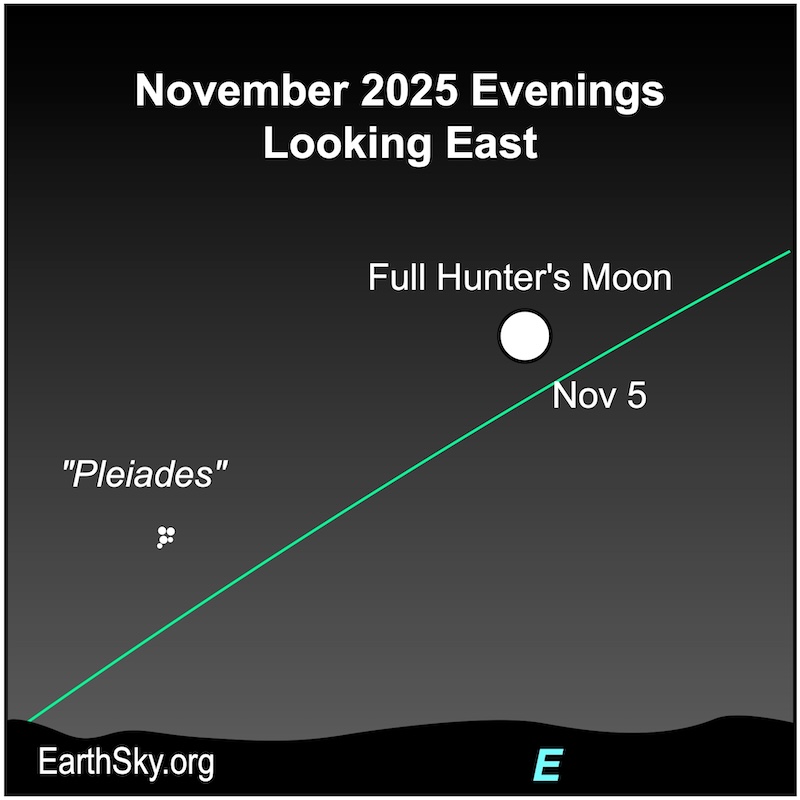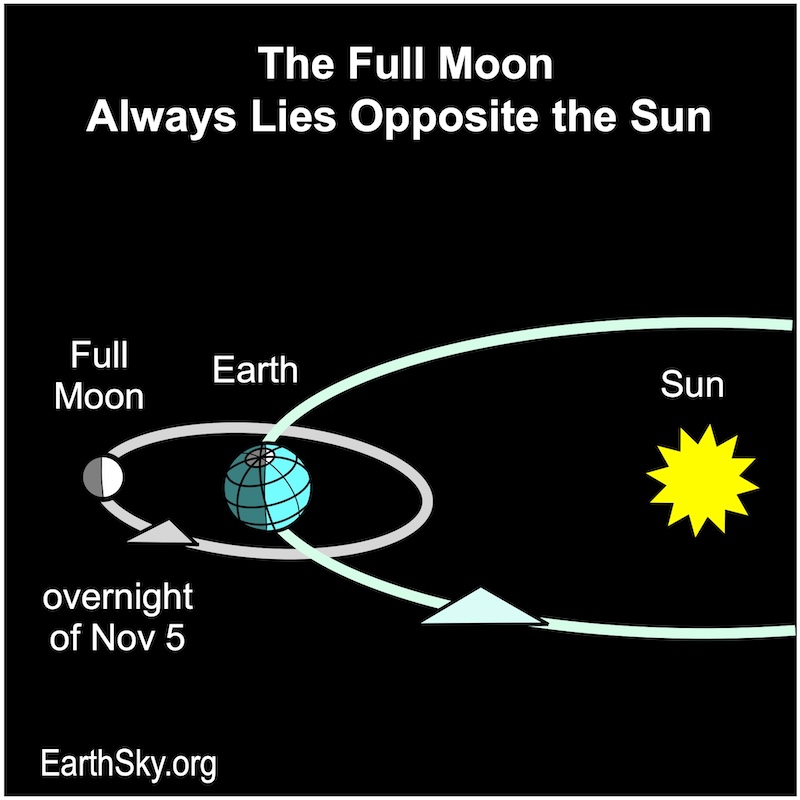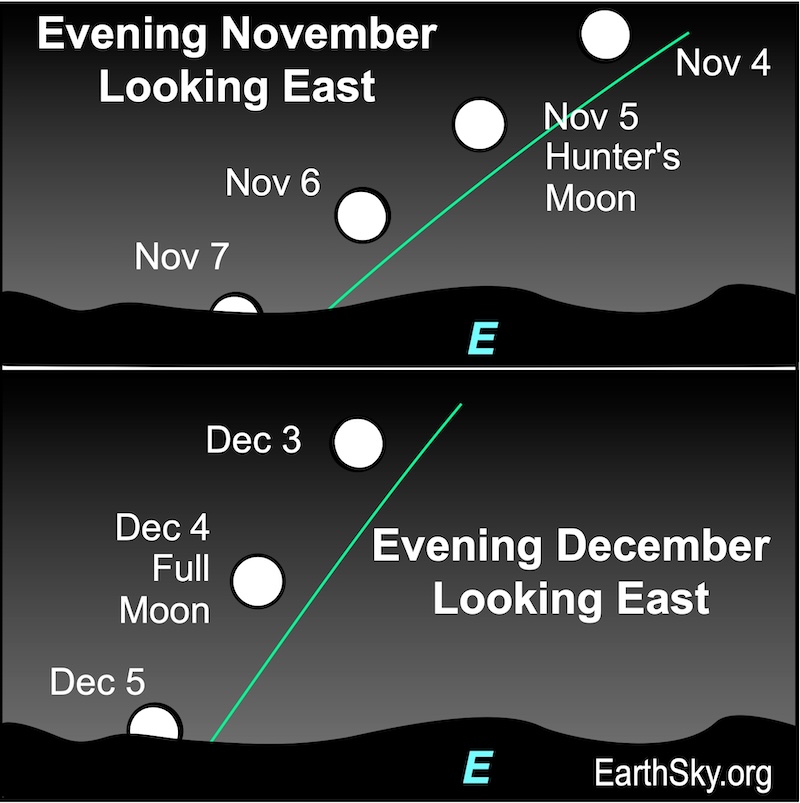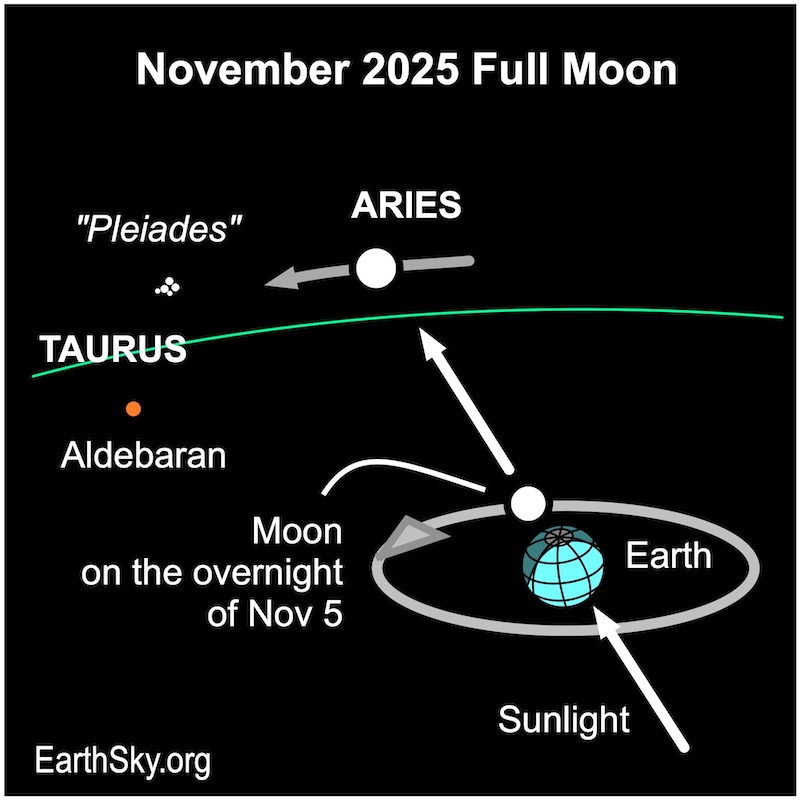
Super Hunter’s Moon follows the Super Harvest Moon
When and where to look in 2025: For all of us on Earth, look for the bright, round full moon rising in the east around sunset on November 5. It’ll be visible all night. This is the Northern Hemisphere’s Hunter’s Moon, the full moon after the Harvest Moon (which is the full moon closest to the autumnal equinox). This Hunter’s Moon is also the second of four supermoons in a row in 2024.
The crest of the full moon arrives at 13:19 UTC on November 5. That’s 7:19 a.m. CST, which is about 30 minutes after sunrise for viewers in central North America. If you want to see the brightest moon of 2025, look in the west on the morning of November 5 before sunrise.
The moon’s perigee, or closest point to Earth for this month, also falls on November 5. It’ll come about 9 hours after the crest of the moon’s full phase. Perigee comes at 4 p.m. CST on November 5 (22 UTC). So this is a very close full moon, known as a supermoon. In fact, it’s the closest supermoon of 2025! So it’ll be the brightest moon of this year.
About the Hunter’s Full Moon
Characteristics of the Hunter’s Moon: The moon is always roundest on the day that it’s full. And, on the day of a full moon, the moon always rises close to the time of sunset. But the nights before and after a full moon feature a round-looking moon, too. And, like the Harvest Moon, this November Hunter’s moon will be characterized by a shorter-than-usual time between successive moonrises for several nights in a row. So Northern Hemisphere dwellers will see full-looking moons in twilight skies, ascending in the east as the sun sets in the west, for several nights around November 5.
For the Southern Hemisphere, the nights around this full moon feature a longer-than-usual time between successive moonrises. So, for the southern part of the globe, the moon will rise on November 6, 7 and 8 (and for many nights after that) in a sky that’s already dark. And your Harvest and Hunter’s Moons center on the March equinox, your autumnal equinox. Much of what we say in this post – the general information about Harvest and Hunter’s Moons – applies to you, too … next March and April.

This is the Hunter’s Moon for 2025
A full moon is always opposite the sun in space, and opposite the sun in our sky. So all full moons rise in the east around sunset. And all full moons set in the west around sunrise. But the various full moons have different characteristics.
The full moons of September, October, and November are referred to by specific names depending on their proximity to the September equinox which falls on either September 22 or 23. This year, it was on September 22. The full moon closest to the September equinox is called the Harvest Moon, and it fell on October 6. The full moon after that, the Hunter’s Moon, can occur in either October or early November. This year it occurs on November 5. This can get confusing since the dates change every year, but here is quick summary for 2025.
- If a full moon of September falls before September 8, it is the Corn Moon. If not, it’s the Harvest Moon.
- If a full moon October falls before October 8, it’s the Harvest Moon. If not, it’s the Hunter’s Moon.
- And if a full moon of November falls before November 7, it’s the Hunter’s Moon. If not, it’s the Beaver Moon.
What makes the Hunter’s Moon special?
Nature is particularly cooperative around the time of the autumnal equinox to make the fall full moonrises special. On average, the moon rises about 50 minutes later each day. But when a full moon happens close to the autumnal equinox – either a Harvest or a Hunter’s Moon – the moon (at mid-northern latitudes) rises about 30 minutes later daily for several days before and after the full moon. (The higher the latitude is, the larger that drop in time.) The reason is that the ecliptic – or, more exactly, the moon’s orbital path which closely follows the ecliptic – makes a narrow angle with the eastern horizon around the time of the autumnal equinox. Note that after mid-November, the moon’s path with respect to the eastern horizon increases in steepness, reducing then eliminating this effect.
The result is that there’s a short-than-usual lag time between successive moonrises around the Hunter’s Moon adding to the brightness of evening twilight.
If you’re in the Northern Hemisphere, look for the moon to be bright and full-looking for several nights from November 3 to 6. On these nights, you’ll see a bright, round moon ascending in the east relatively soon after sunset for a few days in a row.
A great source for moonrise times is the Custom Sunrise Sunset Calendar. Be sure to click the boxes for “moon phases” and “moonrise and moonset times.”
How did the Hunter’s Moon get its name?
There are many stories surrounding the names of the full moons, including the Hunter’s Moon. From a practical standpoint, the Harvest Moon and subsequent Hunter’s Moon provided light in the evenings for farmers and hunters to finish their tasks.
Every full moon has a slew of nicknames tied to months of the year. But some moon names, such as the Harvest and Hunter’s Moons, are tied to seasons. The Harvest Moon is the full moon closest to the September equinox, or autumnal equinox in the Northern Hemisphere. The equinox date is either September 22 or 23. So most Harest Moons come in September. But, every three or four years, as it happens this year, the Harvest Moon falls in early October and the Hunter’s Moon in early November.
In North America, the Harvest Moon was a time when the bright moon meant farmers could stay out later, working the field, gathering the crops before the first freeze. After the harvest, the farmers would turn to hunting deer and other animals to bolster their food stores before winter. The light of the full and almost full moons would let them hunt into the evening hours. So we call it the Hunter’s Moon.

Note that by mid to late November, a full moon’s path with respect to the eastern evening horizon will be steeper, eliminating this effect.
This Hunter’s Moon is also the year’s largest Supermoon
November 2025 sees lunar perigee – the point in the moon’s orbit where it comes closest to Earth – occur about 9 hours after the crest of the full moon. This means it is a perigean full moon – or supermoon. It happens at 22 UTC (or 4 p.m. CDT) on November 5. At this time, the moon lies about 221,817 miles (356,980 km) from us on Earth. For comparison an average full moon lies 238,900 miles (384,472 km) away.
Since it is closer in its orbit to us, does a supermoon appear noticeable larger than an ordinary full moon?
While it is true that experienced observers do say they can detect a brightness difference, you’d have to be a very keen observer to notice it. Truly, most of us can’t tell any difference in the size of a supermoon and an ordinary full moon.
But … do supermoons look brighter than ordinary full moons? Yes! By a noticeable amount. That’s because a supermoon exceeds the disk size of an average-sized moon by up to 8%, and the brightness of an average-sized full moon by some 16%. And then, it exceeds the disk size of a micro-moon (a year’s most distant, and, therefore, smallest appearing full moon) up to 14% and the brightness of a micro-moon by some 30%. So, if you go outside on the night of November 5 (and on the overnight of November 4), there’s a potential you’ll notice the supermoon is exceptionally bright!
And people living along the coast might notice that potentially flooding high tides – sometimes called king tides – will not only occur on but precede and follow a supermoon by a day or two.
Orange color is real
The orange color of a moon near the horizon is a true physical effect. It stems from the fact that, when you look toward the horizon, you’re looking through a greater thickness of Earth’s atmosphere than when you gaze up and overhead. The atmosphere scatters blue light, so that’s why the sky looks blue. Additionally, the greater thickness of atmosphere in the direction of a horizon scatters blue light most effectively, but it lets red light pass through to your eyes. So a full moon near the horizon – any full moon near the horizon – takes on a yellow or orange or reddish hue.
The bigger-than-usual size of a moon seen near the horizon is something else entirely. It’s a trick that your eyes are playing – an illusion – called the Moon Illusion.
However, in 2025, the Hunter’s Moon is a supermoon. And it’s the closest supermoon in 2025. So yes, it will look brighter than an average full moon!

November full moon falls in Aries in 2025
The November full moon can lie in front of one of two constellations of the zodiac, and one additional constellation. Most years, it lies in Taurus, as it did last year and will next year. But it occasionally occurs in Aries, as it does this year. And in 2036, it will land in the large, neighboring constellation immediately south of Aries, Cetus the whale.
Plus, on the evening of the full moon, the Pleiades star cluster is nearby. The light of the very bright supermoon will likely overpower the Pleiades, making the either invisible or challenging to see.
Bottom line: The full Super Hunter’s Moon happens overnight on November 5, 2025. It’s also the year’s largest full supermoon.











